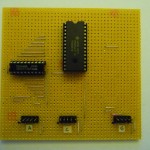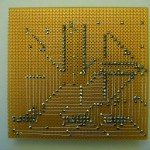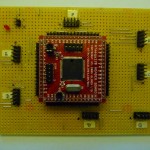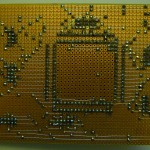A couple of months ago I ordered a ATmega128 header board (AVR-H128) from Olimex. In order to make use of such a header board you need to mount it somewhere. For this purpose I created a sort of header board for the header board. It is very minimal, consisting of mechanical components only except for a LED and a resistor. The reason for that is that the header board on which the ATmega128 itself is placed already contains a +5V voltage regulator (LM78L05) and reset circuit (ZM33064). Using my board its very convenient connecting things to the pins of the micro controller. All ports (A, B, C, D, E, F and G) have a separate 10 (2×5) pin header where the last two pins of each header is connected to GND (9) and VCC (10).
The layout of the board was created with the intention in mind to be able to assemble it in a through-hole fashion. Needless to say that the layout can also be used to etch or mill the board.
There are still things that can be enhanced like adding a connector for the reference voltage of the ADC (AREF).
Download
Schematics and layout have been created using Eagle 5.11 with a non-commercial license. The outline of the board is 100x160mm, so for you folks that use the Eagle freeware you will not be able to modify the boards layout (since Eagle as freeware only allows for boards with a outline of 100x80mm).





